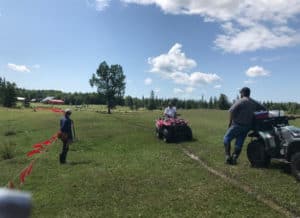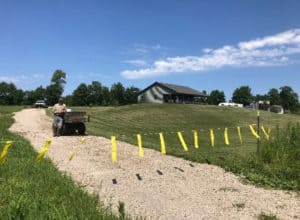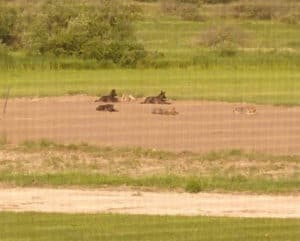Share this article
Partners deploy fladry in Minnesota wolf country
Cooperative management partnerships between Wildlife Services-Minnesota and two environmental advocacy organizations reduced wolf presence in human safety and livestock protection situations this summer. Both locations were sites where gray wolves (Canis lupus) were known to be present.
In one Mille Lacs County site, six young wolves were repeatedly observed, sometimes within 50 yards of a residence. The family living at the home expressed concern over the potential threat to human safety because two young children regularly played outside.

Fladry serves as a barrier between a residence where small children play and the surroundings from which the wolves had been approaching. ©USDA-Wildlife Services
Having observed the wolves near the home, the next day Wildlife Services used voice howling — a technique often used to locate wolves — to attract them to within a half mile of the house. WS then launched several pyrotechnic noise devices in the wolves’ direction to deter them from the area and deployed about a half mile of fladry around the residence. Fladry is visual deterrent consisting of colored flags on a line of rope (which may be electrified) serving as a barrier to deter predator access to areas where their presence is not beneficial.

Deployed fladry surrounds an Itasca County sheep pasture where chronic wolf depredation has been occurring. ©USDA-Wildlife Services
Since the deployment, the family has not seen or heard the wolves.
In another operation, fladry was installed at a Northern Itasca County farm with a long history of wolf depredations on sheep and cattle. Wildlife Services had verified that a wolf had killed one sheep at this site in early July. Traps were set for 13 days following that loss but resulted in no wolf captures and subsequently were removed. No further livestock losses were reported until early August when tracks and droppings were noticed again. With assistance from the Natural Resources Defense Council, WS deployed about 1.4 miles of electrified fladry — known as turbo fladry — around that sheep pasture. No livestock losses have been reported here since fladry was installed.

Six wolves were observed regularly within close proximity to a rural residence and yard where young children play. ©USDA-Wildlife Services
WS will continue to monitor the two sites to determine the effectiveness of fladry as a tool to prevent or reduce further conflicts with wolves.
Minnesota is home to 2,300-3,300 wolves, classified as a threatened species. About 1 to 2% of farms in Minnesota’s wolf range experience predation, but the losses to individual producers can be significant. In 2018, we verified 113 complaints at 97 sites and more than 100 cattle or calves lost or injured. WS specialists are documenting producer-implemented nonlethal practices: 5% using fladry; 12% livestock protection dogs; 62% using proper carcass disposal; and more than 80% using fencing or increased human presence.
Header Image: Partnerships with private individuals and advocacy organizations are deploying fladry to decrease conflicts between wolves and people. ©USDA-Wildlife Services








